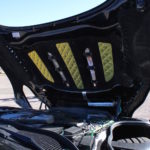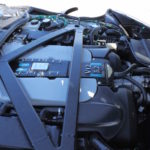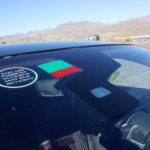The Aston Martin DB11 sports car is a project whose worth to the brand cannot be overstated. Not only is the grand tourer set to succeed one of the most highly praised vehicles ever to wear a winged-badged – the DB9 – it will also initiate a series of new and redesigned offerings between now and 2020. The underlying theme, of course, is that extensive development of the all-new vehicle is crucial to its success.
To understand just how extensive Aston’s development process is, I joined Chief Engineer Ian Hartley in Phoenix, Arizona to ride shotgun in a pre-production DB11. I don’t need to tell you that Phoenix in June is a desperately warm setting, but it happens to be perfect conditions for hot weather testing.
The DB11: An All-New Aston
It’s probably best to start with a refresher on what we know about the DB11. Due sometime next year, the sports car will be Aston Martin’s first application of a twin-turbocharged V12 motor. More specifically, the new powertrain displaces 5.2 liters and produces 600 horsepower. Motivation will be achieved through the rear wheels via a ZF eight-speed automatic transmission (the same unit that’s found on the current Vanquish flagship). A new aluminum structure will house entirely distinct designs inside and out, previewed by the DB10 of Spectre. Aston Martin’s recent collaboration with Mercedes-Benz will yield a twin-turbo V8 engine down the road, but for now, the DB11 borrows MB’s electronic architecture (steering column, infotainment system and controller, and digital displays).
Related: Aston Martin On Ice Driving Program
The DB11 has been in development for nearly three years to this point and the final stages of testing, which will overlap with a media preview next month, are of a more fine-tuning nature than major overhaul. It’s expected that the DB11’s new platform will underpin replacements for both the Vantage and Vanquish, and the upcoming DBX crossover. Though the interior and exterior of my hot weather prototype was marred by sensors, wires, and additional monitors, it’s clear that this will be one of the finest designs ever to ship from Gaydon, UK. Aston has always been praised for its outer aesthetic, but its cabins always left much to be desired. The story will be quite different as photos and my own experiences will tell you. The DB11 may indeed offer a luxury experience to match its visual and audio delights.
Tracking High Heat
Mr. Hartley has been with Aston Martin for 27 years, in which time he’s advanced from a simple mechanic to one of the lead development engineers on the DB11 and other storied Aston models. If there’s anyone who can rightfully express enthusiasm and historical context for the DB11, it’s him. Though I never took the wheel of the DB11 prototype, I did receive more than my fair share of information about the car and about what Hartley’s team was evaluating in 111 degrees.
What would start in Arizona would take a small group of engineers to and from Las Vegas, NV (twice) and cover approximately 15,500 miles. Highways, cities, mountains, and thick traffic were all part of the plan. The only constant would appear to be brutal heat. Not to make things easy on themselves, Aston Martin chose a black DB11, complete with black exterior trim and dark wheels to draw as much heat from our fair sun as possible. The British marque then set about equipping over 200 sensors to the exterior, interior, engine bay, and windows, each channeling a bright green wire to the trunk where the gathered mess is what Hartley referred to as “green spaghetti.” The name is accurate: nearly every square inch of the respectably large boot was stuffed with neon cable and shiny metal boxes.
Among the slew of data points being assembled, the coolant levels, fan strategies, oil temperature, and suspension durability are among the highest priorities. “We’ve come to test the mechanisms most prone to high-heat damage,” said Hartley. “Just like our cold climate tests in Finland, these heat soak tests are critical to delivering the best finished product.” While about a dozen readouts constantly adjusted on a standalone monitor directly in front of my seat, Hartley also described Aston’s attention to carpet, leather, and panel degradation. “We use historical customer concerns to guide some of our interior tests and combine those with engineering evaluations.” Hartley mentioned that many years prior, customers had complained of the DB7’s leather and plastic panels warping from heat over time.
In addition to high speed and handling maneuvers, Aston Martin will park the DB11 facing a wall, restricting airflow thru the front grille, and leave it running for hours. “We’ll also try letting the car soak in the sun for a while before turning it on to test how quickly the air conditioning cools the cabin.” It all sounds like vehicular torture, to the scale that no self-respecting Aston Martin owner would ever subject his or her vehicle, but I suppose that’s the point of finding limits.
Development Stages
Aston Martin has produced 110 pre-production DB11 vehicles as of this writing. Those prototypes have been spread across a few different stages of development, from X1 to M1, to VP, to TT, and finally to PP. While the X1 and M1 nameplates merely signify different statuses of underbody and upper body shape, the others stand for Verification Prototype (VP), Tuning Trial (TT), and Pre-Production (PP). In Arizona, I experienced a TT unit, which is used for software calibration. Steering, suspension, throttle mapping, and other driving dynamics go through a refining process during the TT stage.
Each stage of development includes a more or less nescient version of each component, according to Hartley. For example, when testing steering ratio and responsiveness, there will be a “steering” car at each X1, M1, VP, and TT stages of development. This not only helps Aston Martin track progress over time, it narrows each engineer’s focus to that variable for better adjustment.
Related: Aston Martin DB9 GT First Drive Review
Considering the extent of development, it makes sense that Aston Martin works with a few key partners to design and test certain components. Bosch and Continental are two suppliers who Hartley said will perform their own safety and software testing, leaving Aston Martin to tune or give feedback to match their performance goals. “We bring these suppliers into the development process at the first stages of new product planning,” said Hartley. “We’ll even ship them a vehicle to use for internal testing.” Aston starts by sending their suppliers a “product definition letter” that outlines a need for a (blank) car with (blank) attributes to sell to (blank) customers. If that supplier can meet those needs, Aston Martin will immediately begin collaboration, otherwise it will look outside its present network. The automaker’s new partnership with Mercedes-Benz ranks among its most involved relationships yet.
At the conclusion of each day, Hartley’s team submits issue logs to the mother ship (Gaydon HQ). “Now that we’re in the final stretch, these guys are working 12 hour days at least,” said Hartley. If the team does happen to notice an issue (“and we’re not expecting to find any major problems at this stage”), they take two courses of action. The first is to assure that this particular vehicle has the latest part, and assuming it does, the second is to raise a formal concern, which puts a “red status” on that issue for immediate remedy.
Fine Tuning
Certainly Aston Martin isn’t the only automaker to go to such lengths to prepare a new vehicle for launch, but the granularity of its process and the dedication of its team is truly remarkable. Though Mr. Hartley spends the majority of his time hard at work in Aston’s UK headquarters, it’s clear to see his passion for the brand, and specifically the DB11, comes alive during his on-location assignments. I’m itching to get my hands on the automaker’s initial player among an all-new lineup, but my patience will be rewarded with some incredible Italian roads next month; stay tuned.

























